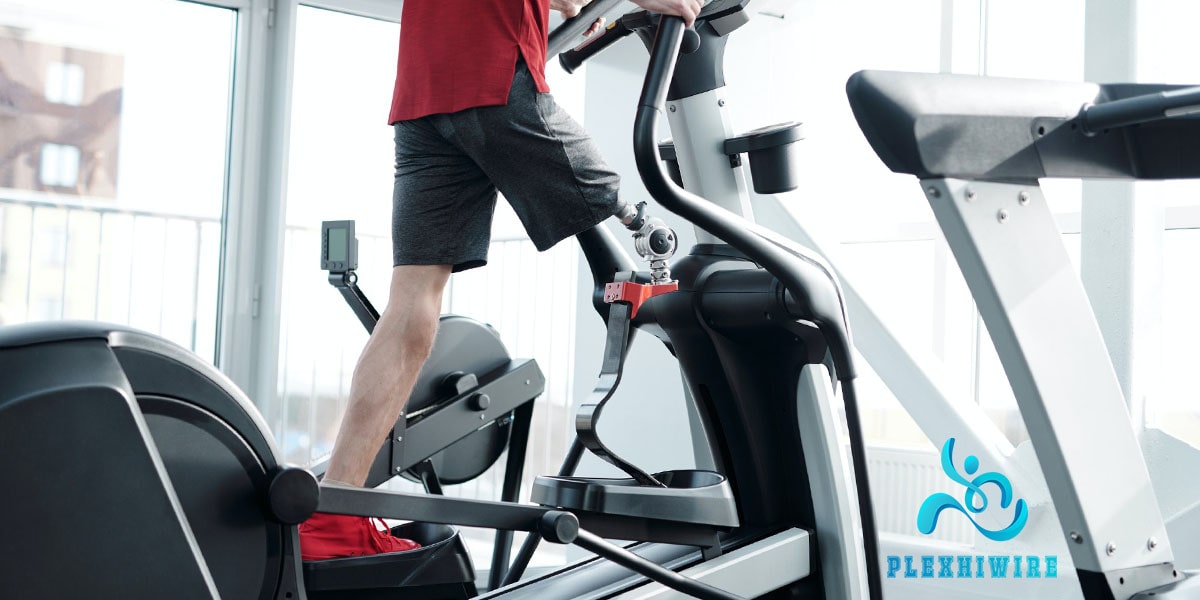How Many Miles on a Stationary Bike Equals 10000 Steps?
Do you ever find yourself wondering how to incorporate more physical activity into your day-to-day life? Taking the stairs instead of elevators, parking farther away from your destination, and taking 10-minute movement breaks have become a part of our daily lives. But what if one were able to maximize their movements while still seated? Today we’re talking about stationary bikes – an incredible workout machine that allows for maximum effort without having to leave the comfort of your home. So, have you ever wondered how many miles on a stationary bike it takes to reach the same amount of steps as walking 10,000 steps? With growing research emerging regarding the importance of regular physical activity, and with most step counters tracking up to 10,000 steps per day as an indication of success in fitness goals – more and more people have been asking this very question.
In the post “How many miles on a stationary bike equals 10000 steps?”, we’ll discuss why cycling is such an effective way for reaching your step count goals while also exploring different tips and tricks for making the most of your cardio experience. Get ready to take advantage of the gym’s spin bike class and start monitoring how many miles on a stationary bike equals 10000 steps! Whether you’re trying to get fit for just general health or for a particular event such as climbing a mountain – understanding exactly how much effort is required can be incredibly helpful in planning your workouts and staying motivated! Read on to learn about different types of bikes, their features & benefits – along with average calorie burns based on real-world scenarios.
- How Many Miles on a Stationary Bike Equals 10000 Steps?
- What is the Importance of Taking 10000 Steps a Day for Exercise And Health Benefits?
- How Many Miles on a Stationary Bike Equals 10000 Steps?
- What is the Difference Between a Stationary Bike and Running 10000 Steps?
- What Types of Cardiovascular Workouts Can be Done on a Stationary Bike?
- How Much Time Does It Take for a Person to Complete 10000 Steps on a Stationary Bike?
- How Can You Boost Your Calorie Burn on a Stationary Bike
- What Kind of Intensity Levels Should You Reach to Maximize Your Workout When Biking 10000 Steps?
- What is the Connection Between Stationary Biking and Taking 10000 Steps a Day?
- Is There Any Additional Equipment Necessary for an Effective Stationary Bike Workout?
- How Can I Track My Progress and Measure How Many Miles I’m Biking?
- Frequently Asked Questions
- Conclusion
What is the Importance of Taking 10000 Steps a Day for Exercise And Health Benefits?
Leading a sedentary lifestyle has become a common issue for many people worldwide. Sitting at a desk for extended periods of time, taking the elevator instead of the stairs, and relying on cars instead of walking can contribute to a lack of physical activity which can harm our health over time. In this regard, taking 10000 steps a day has become an increasingly popular exercise recommendation. This practice promotes a more active lifestyle and comes with significant health benefits.
So, why is walking 10,000 steps per day considered an important goal for achieving good health? To begin with, research has demonstrated various benefits of physical activity on the body, including the reduction of the risk of chronic diseases such as obesity, type II diabetes, cardiovascular disease, and cancer, among others. Regular physical activity can also help improve the immune system, promote better sleep, and positively affect mental health by reducing symptoms of depression and anxiety.
Walking is a low-impact exercise that most people can engage in without much risk of injury, making it an ideal form of physical activity. Walking 10,000 steps per day is equivalent to a distance of approximately 5 miles or 8 kilometers, which requires consistent effort. Many individuals find that achieving this goal helps them stay motivated and accountable for their physical activity levels, leading to improved fitness and overall health outcomes.
Furthermore, walking 10,000 steps per day is beneficial because it can be done throughout the day, without a specific time commitment, making it more accessible. This can include walking during leisurely activities, such as sightseeing or hiking, or as part of a daily commute. Additionally, walking is an inclusive form of physical activity; it doesn’t require any specialized equipment or a particular setting.
In conclusion, taking 10,000 steps a day is an essential goal for achieving overall good health through daily physical activity. It provides various benefits such as improving the immune system, promoting better sleep, and positively affecting mental health. There are no age or gender restrictions, making it a suitable exercise for anyone, regardless of their fitness levels. Over time, walking 10,000 steps per day is a manageable task that can lead to significant, long-term health benefits.
How Many Miles on a Stationary Bike Equals 10000 Steps?
A stationary bike is a great alternative for individuals who prefer indoor workouts or those who wish to avoid outdoor conditions. This equipment allows people to work on their cardiovascular health, strength training, and overall fitness. On the other hand, a pedometer is a device that counts the number of steps an individual takes while walking or running. It has been mentioned that doctors recommend walking at least 10,000 steps per day to promote a healthier lifestyle.
With this in mind, if one were to use a stationary bicycle as their workout routine and would like to match the benefits of walking 10,000 steps, the question arises: how many miles on a stationary bike equal 10,000 steps?
According to a study by Harvard Health Publishing, a person biking at a moderate pace of 12-13.9 miles per hour can burn an average of 298-399 calories in 30 minutes, depending on their weight. Based on this estimation, we can conclude that biking 5 miles at this moderate pace can burn around 298-399 calories, similar to the number of calories burned from walking 10,000 steps.
Read more: What is Zwift? – A Guide To Indoor Cycling
In terms of the conversion of miles to steps, it’s worth mentioning that this depends on the length of an individual’s stride. On average, a person’s stride is around 2.5 feet. Multiplying this number with the number of steps (10,000) results in a total of 25,000 feet. Converting this to miles is done by dividing 25,000 feet by 5280 (the number of feet in a mile) resulting in approximately 4.73 miles.
Therefore, it can be concluded that biking at a moderate pace for approximately 4.73 miles on a stationary bike can provide the same health benefits as walking 10,000 steps. However, it’s important to note that this estimation varies based on factors such as age, weight, gender, and fitness level. Always consult with a physician before starting any new exercise routine.
What is the Difference Between a Stationary Bike and Running 10000 Steps?
Both stationary biking and running 10,000 steps are popular forms of cardio exercise that can help improve cardiovascular health, increase endurance, and aid in weight management. While both activities promote similar benefits, they differ in several ways.
Firstly, stationary biking is a low-impact exercise, which means it puts less stress on the joints than running. This makes it a good alternative for individuals who are prone to joint pain or have existing joint problems. On the other hand, running involves high impact, which can lead to joint strain and even injury in the long run.
Another difference is that running 10,000 steps requires more physical effort and energy expenditure than stationary biking for the same amount of time. Running is a weight-bearing exercise that engages several major muscle groups, including the legs, glutes, hips, and core, leading to a higher calorie burn. Stationary biking, on the other hand, involves less weight-bearing and uses primarily the leg muscles for pedaling.
Additionally, the intensity of a stationary biking session can be varied more easily, as the resistance can be adjusted according to an individual’s fitness level and preferences. Running, on the other hand, can be difficult to regulate in terms of intensity, as it largely depends on factors such as terrain, incline, and pace.
Finally, while both exercises can improve cardiovascular health, their specific effects may differ. Research suggests that running may have a greater impact on improving long-term heart health, while stationary biking can be more effective in improving blood pressure and overall vascular function.
In summary, while both stationary biking and running 10,000 steps can provide numerous health benefits, they differ in terms of joint impact, energy expenditure, intensity regulation, and specific effects on cardiovascular health. Choosing the right exercise ultimately depends on an individual’s fitness level, preferences, and health goals.
What Types of Cardiovascular Workouts Can be Done on a Stationary Bike?
Cardiovascular exercise is crucial for maintaining optimal health, and cycling is a popular activity for individuals looking to improve their cardiovascular fitness. A stationary bike provides a practical and efficient way to get a great cardiovascular workout in the comfort of your own home or at the gym. There are various types of cardiovascular workouts that can be done on a stationary bike, each with its unique benefits.
Interval Training: Interval training on a stationary bike involves alternating between periods of high-intensity cycling and low-intensity recovery periods. This type of workout is great for improving cardiovascular fitness, as it challenges the heart and lungs to work harder and adapt to changing intensities.
Hill Climb: This type of workout involves increasing resistance on the stationary bike to simulate riding up a steep hill. Hill climb workouts are excellent for strengthening the leg muscles and improving endurance.
Endurance Ride: An endurance ride on a stationary bike involves maintaining a steady, moderate intensity for an extended period of time. This type of workout is suitable for individuals who want to build their cardiovascular endurance gradually.
Speed Training: Speed training involves pedaling as fast as possible while maintaining good form. This type of workout is ideal for improving leg strength, coordination, and cardiovascular fitness.
Recovery Ride: A recovery ride on a stationary bike involves cycling at a low intensity to aid in muscle recovery and help the body return to its resting state.
Stationary bikes offer a range of cardiovascular workout options that can be tailored to meet different fitness goals. Whether you’re looking to improve endurance, build leg strength, or increase your overall cardiovascular fitness, there is a stationary bike workout that can help you achieve your goals. So, hop on your stationary bike and start pedaling towards a healthy heart and body!
How Much Time Does It Take for a Person to Complete 10000 Steps on a Stationary Bike?
Stationary bikes have become increasingly popular in recent years due to their convenience and ability to provide an effective cardiovascular workout. With the rise of fitness trackers and step counters, many individuals aim to accomplish a certain number of steps per day to promote their overall health. However, for those who prefer cycling to walking, the question may arise: how long does it take to complete 10000 steps on a stationary bike?
To accurately answer this question, several factors must be taken into consideration. First and foremost, the intensity of the workout plays a significant role in determining the duration of the exercise. Higher-intensity workouts will typically result in faster step accumulation, while lower-intensity exercises may take longer to reach the goal.
Additionally, the individual’s fitness level, body composition, and age can all impact the speed at which they are able to cycle and accumulate steps. For example, a highly trained athlete will likely be able to complete 10000 steps more quickly than a sedentary individual.
Research shows that a person with an average level of fitness may take approximately 45-60 minutes to complete 10,000 steps on a stationary bike, provided they exercise at a moderate intensity. However, those who are more physically fit and have a higher resistance level may complete the task in a shorter amount of time, whereas those who are less active or have a lower resistance level may require more time to reach their goal.
How Can You Boost Your Calorie Burn on a Stationary Bike
If you’re looking for a low-impact but effective way to burn calories and improve your fitness, a stationary bike is an excellent choice. However, if you want to maximize your calorie burn and get the most out of your workouts, there are several strategies you can use. Here are some tips to boost your calorie burn on a stationary bike:
Increase resistance: One of the easiest ways to burn more calories on a stationary bike is to increase the resistance. This will make your muscles work harder and require more energy, which in turn burns more calories. Start with low resistance and gradually increase it as you get stronger.
Incorporate intervals: Interval training involves alternating short bursts of high-intensity exercise with periods of lower intensity. This technique is proven to be highly effective for burning calories and improving cardiovascular fitness. Try adding intervals to your stationary bike workout by pedaling fast for 30 seconds, then slowing down for a minute or two. Repeat this pattern for several rounds.
Use proper form: Proper form is essential for efficient and effective pedaling on a stationary bike. Make sure your knees are bent slightly and your feet are flat on the pedals. Keep your back straight and your elbows relaxed. This will help you engage your muscles more effectively and burn more calories.
Add upper body exercises: To boost your calorie burn even further, consider adding some upper body exercises while you pedal on the stationary bike. Try doing bicep curls, tricep extensions, or shoulder presses with light weights while you cycle. This will help you engage more muscles and burn more calories overall.
Stay hydrated: Finally, don’t forget to stay hydrated during your workouts. Water is essential for proper muscle function and can help you maintain your energy levels throughout your ride. Aim to drink at least a few sips of water every 10-15 minutes.
See more: Get Ready for an Intense HIIT Stationary Bike Workout
By following these tips and incorporating them into your stationary bike workouts, you can boost your calorie burn, improve your fitness, and achieve your goals more efficiently. So grab your water bottle, hop on your bike, and get ready to pedal your way to a healthier you!
What Kind of Intensity Levels Should You Reach to Maximize Your Workout When Biking 10000 Steps?
One of the most effective ways to get fit and stay healthy is to incorporate regular exercise into your daily routine. Biking has long been a popular form of exercise and is an excellent way to achieve your fitness goals. If you are aiming to bike 10000 steps, you may be wondering about the optimal intensity levels to maximize your workout.
To get the most out of your cycling workout, it is recommended to aim for a moderate to high level of intensity. Moderate intensity refers to exercising at a level where you can still hold a conversation, but are breathing a little heavier and sweating a bit more than usual. High-intensity exercise, on the other hand, involves pushing yourself to the limit and typically results in heavy breathing, a significant increase in heart rate, and sweating profusely.
Research shows that high-intensity interval training (HIIT) is particularly effective for maximizing the benefits of cycling. HIIT involves alternating short bursts of high-intensity exercise with periods of more moderate exercise or rest. This type of workout has been shown to effectively improve cardiovascular health, boost metabolism, and increase endurance.
Aside from the physical benefits, biking at moderate to high intensity can also have positive effects on mental health. Exercise releases endorphins, which are natural chemicals that promote feelings of happiness and well-being. Additionally, cycling outdoors can provide a sense of serenity and peace that helps reduce stress and anxiety.
To maximize your workout and achieve the most significant health benefits when biking 10000 steps, aim for a moderate to a high level of intensity. Incorporating HIIT into your routine can be particularly effective in achieving your fitness goals. Remember to listen to your body and gradually work your way up to higher levels of intensity as you become more comfortable.
What is the Connection Between Stationary Biking and Taking 10000 Steps a Day?
Stationary biking and taking 10,000 steps a day are two common strategies often used to maintain or improve physical health and fitness. While each activity may be performed separately, there is a connection between both that can be mutually beneficial when combined.
Stationary biking is a low-impact cardiovascular exercise that can be performed indoors on a specialized exercise bike. It offers numerous benefits, including increased calorie burning, which can aid in weight loss, and enhanced cardiovascular health, muscle strength, and endurance. Moreover, stationary biking can be a less strenuous and more manageable way to maintain consistent levels of physical activity, particularly for individuals with limited mobility or access to outdoor exercise options.
On the other hand, walking 10,000 steps a day has become a widely recognized goal and benchmark for achieving better fitness and health outcomes. Walking regularly has been shown to lower the risk of chronic diseases, improve cardiovascular health, and help with weight management. Also, walking outdoors offers additional benefits, including exposure to sunlight and improved emotional well-being.
The connection between stationary biking and walking 10,000 steps a day lies in the fact that both activities are great ways to increase daily physical activity levels, which is a crucial component of a healthy and active lifestyle. Combining these two activities can provide a more comprehensive workout, leading to improved overall physical fitness, including increased endurance and strength. Moreover, performing both exercises regularly might help offset the harmful effects of a sedentary lifestyle, which can lead to several health problems.
To sum up, while stationary biking and taking 10,000 steps a day are individual activities, collectively, they can help to improve physical health via an enhanced amount of daily physical activity and diverse workout routines. By incorporating both exercises into daily routines, individuals can optimize their physical activity levels, improve overall fitness and well-being, and reduce their risk of chronic diseases.
Is There Any Additional Equipment Necessary for an Effective Stationary Bike Workout?
Stationary bikes are a popular piece of exercise equipment that provides a low-impact and highly effective cardiovascular workout. While these bikes offer a convenient way to get your daily dose of exercise, it is essential to consider if there is any additional equipment that can further improve the effectiveness of your stationary bike workout.
One type of equipment that can elevate your stationary bike workout is cycling shoes. These shoes feature stiff soles that evenly distribute pressure across your feet, providing better stability and support during your workout. They also have cleats that enable you to clip onto the pedals of your stationary bike, allowing for a more efficient pedaling motion. Additionally, cycling shoes can help prevent injuries, such as ankle or foot strains, that may arise from cycling in regular shoes.
Another valuable tool to enhance your stationary bike workout is a heart rate monitor. This device allows you to monitor your heart rate during your workout, giving you a more accurate understanding of the intensity of your exercise. By keeping your heart rate within your target range, you can ensure that you are maximizing the cardiovascular benefits of your workout while minimizing the risk of injury or overexertion.
A third piece of equipment to consider is a fan. While it may seem like a non-essential addition, a fan can make a significant difference in your comfort level during a stationary bike workout. As you cycle, your body generates heat, causing you to start sweating and feeling overheated. A fan can help to keep you cool and comfortable throughout your workout, allowing you to push yourself to your limits.
While a stationary bike is a fantastic piece of equipment on its own, incorporating additional equipment, such as cycling shoes, a heart rate monitor, or a fan, can help to take your workout to the next level. From improved stability and support to precise monitoring of your exercise intensity, adding these tools to your routine can have a significant impact on the effectiveness of your stationary bike workout.
How Can I Track My Progress and Measure How Many Miles I’m Biking?
If you’re an avid cyclist, it’s important to track your progress and measure the distance you’ve covered to stay motivated and achieve your fitness goals. Fortunately, in today’s digital age, there are several tools and technologies available that can help you easily track your biking miles and monitor your progress.
One of the most popular methods to track your progress is to use GPS-enabled fitness trackers or apps, such as Strava, MapMyRide, Garmin, and others. These apps use GPS technology to track the route you take, the distance you travel, and the speed at which you cycle. They also provide additional features like heart rate monitoring, calorie intake and output, and more, making it easier to monitor and manage your biking routine.
Another method to track your progress is to invest in a cycling computer or speedometer that attaches to your bike’s handlebar. These devices use sensors to track your biking miles and provide real-time data on your speed, distance, and time. Some of these devices also come equipped with GPS technology, as well as other advanced features like cadence and power meters, to provide a more comprehensive view of your biking performance.
Lastly, you can also use a traditional pedometer or activity tracker to keep track of your total daily steps and estimate how many miles you’ve biked based on your stride length and other metrics. While these methods may not be as accurate as GPS-enabled devices, they can still provide a general estimate of your biking miles and help you stay motivated to reach your fitness goals.
Overall, there are several effective ways to track your biking miles and measure your progress. Whether you choose to use a GPS-enabled fitness tracker, a cycling computer, or a more traditional pedometer, tracking your biking miles regularly can help you stay motivated, monitor your progress, and achieve your fitness goals.
Frequently Asked Questions
How Many Steps Per Mile on a Stationary Bike?
While cycling on a stationary bike may feel like a different kind of workout compared to walking or running, that doesn’t mean you can’t measure your progress in steps. As it turns out, you can estimate the number of steps you take on a stationary bike per mile to be around 440. This gives you a helpful metric to track your progress and set new goals for your cycling workouts. Plus, it’s another reminder that every movement counts towards improving your overall fitness and health. So whether you’re taking 10,000 steps a day or 440 steps per mile on a stationary bike, keep on moving towards your wellness goals.
How Many Steps is 5 Miles on a Stationary Bike?
Cycling can be a great way to get a vigorous workout without leaving the comfort of your own home. However, it can be tough to know just how much progress you’re making when you’re pedaling away on a stationary bike. If you’re wondering how many steps you might expect to take during a 5-mile ride, the answer is about 3,900 steps. That’s quite a few steps to take, but it’s important to remember that everyone’s pace can vary quite a bit based on factors like fitness level, intensity, and bike resistance. With practice and dedication, you may find yourself covering more and more ground with each ride!
How Many Steps is 30 Minutes on a Stationary Bike?
If you’re looking to get your heart rate up and work those legs, hopping on a stationary bike can be a great option. But have you ever wondered just how many steps you’re taking during your ride? While it may feel like you’re just pedaling away with no clear “step” count in mind, the truth is that 30 minutes on a stationary bike can add up to quite a few steps. In fact, a quick calculation shows that if you’re pedaling at a moderate pace, you’ll take around 116 steps per minute. Multiply that by 30, and you’re looking at a total of 3,480 steps in half an hour! That’s a serious workout for your lower body, and it’s one that you can easily track with a fitness tracker or pedometer.
Conclusion
Cycling on a stationary bike is a great way to reach your physical health goals and get some much-needed cardio in. Now you know exactly what to aim for when hopping onboard your stationary bike to get the most out of your workouts. Also, while this level of activity works for some people, those with more vigorous workout needs might want to adjust as need be; using calorie-tracking apps can be helpful in figuring out how far you need to go in order to hit your fitness goals.
It’s clear that stationary bikes can be a great way to get in your 10,000 steps if you don’t have the opportunity to do them by walking or running. MPG calculations vary and depend on the type of bike you own and your individual riding style. Taking into account factors such as terrain, wind, air resistance, weight, and the intensity of your workout will all affect how far you travel on a stationary bike for 10,000 steps. decide it’s up to you to decide how much time and effort you want to put in when deciding how many miles it takes to reach 10,000 steps. Make sure that when incorporating a stationary bike workout into your routine each day, you take care of yourself, both mentally and physically. Use this as a tool to reach your fitness goals; while also taking breaks in between sessions.
Hope the article “How many miles on a stationary bike equals 10000 steps?” will answer your questions. Have fun with it!








